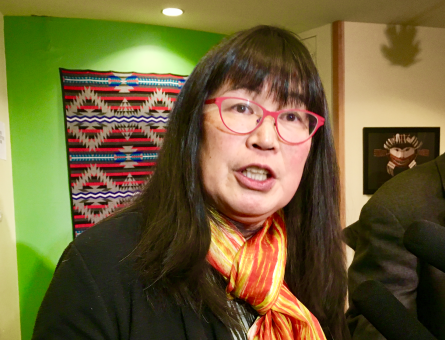
Mayor Tim Burgess: “Business as usual is not really an option.”
Homeless service providers and the city of Seattle say they’re confident that they can double the number of people moved from homelessness to permanent housing in the next year through a combination of traditional tools like permanent supportive housing and private market-based solutions like rapid rehousing with short-term rent assistance vouchers. Yesterday, the city’s Human Services Department released a list of programs, operated by 30 local organizations and agencies, that will receive $34 million in new homeless service contracts. By this time next year, Mayor Tim Burgess predicted yesterday, the city will have moved “more than twice as many people from homelessness to permanent homes compared to this year.” Burgess added that he has “confidence … that the new approach will be effective. …I recognize this is a huge change, but it’s a huge change motivated by the scale of the need that we face on the streets of Seattle. Business as usual is really not an option, because we’re not moving enough people off the street and into permanent housing.” See below for sassy footnote.*
The city also released a list of the dozens of projects that did not receive city dollars because they failed to meet HSD’s new funding standards, which prioritizes low-barrier shelters and programs that promise to get people into housing quickly over longer-term transitional housing and “mats-on-the-floor” shelters that have high barriers to entry and don’t emphasize permanent housing. This year, according to HSD, 56 percent of the city’s shelter funding goes to bare-bones night shelters; as of next year, “mats-on-the-floor” shelters will make up just 15 percent of HSD’s shelter budget, with the remainder going to enhanced shelters. Overall, there will be 300 fewer HSD-funded shelter beds in the city.
Several longstanding programs will be defunded partially or completely, including the SHARE/WHEEL nightly shelter program, which provides high-barrier nighttime-only shelter to about 200 people per night. (SHARE’s shelters are high-barrier because they require adherence to a long list of rules that varies from shelter to shelter, require prospective shelter residents to pass a “screen” by a current member, and restrict residents’ comings and goings—for example, by requiring them to stay at a shelter consistently for a certain number of nights.) HSD deputy director Jason Johnson confirmed yesterday that SHARE’s application for $694,153 to run its shelters ranked dead last among all applications for emergency shelter service funding; its sister organization for women, WHEEL, also ranked poorly, according to HSD.
HSD deputy director Jason Johnson said that in deciding which providers received funding, the agency prioritized “quality” over “quantity,” noting that having to line up every night for a shelter bed is stressful and makes it harder for homeless people to improve their lives.
“Ideally, we want to support people living in their own choice community,” HSD director Catherine Lester said, but “for me, a more important ideal is that we’re supporting people living inside, and unfortunately, there are times when it means people will be living outside of their choice community.”
In response to yesterday’s announcement, SHARE released a portion of the application it submitted to HSD (the full applications will be unavailable, HSD officials said, until after an appeal period concludes on December 12), which asserted that the city’s goal of drastically increasing the rate at which people move from homelessness to permanent housing “is a painful impossibility considering the lack of affordable housing in Seattle. Demanding it forces competition, false promises, and a practice commonly called ‘creaming’—programs rejecting hard-to-serve folks to gain better housing outcomes.” SHARE has been vocal during the city council’s budget deliberations, and will almost certainly show up at city hall to protest the cuts; they will still receive funding to operate the city’s six sanctioned tent encampments.

Low Income Housing Institute Director Sharon Lee
HSD’s prediction about how successful its new approach will be does appear optimistic in light of the high, and growing, cost of living in Seattle, where a one-bedroom market-rate apartment might cost $1,800 to $2,000. As Low-Income Housing Institute director Sharon Lee, whose organization lost funding for two transitional housing projects in the Central District and Georgetown, noted pointedly, permanent housing is always the ultimate goal—but vouchers for formerly homeless people to rent on the private market will only work if people can go from minimal or no income to a relatively high income extremely quickly. If, as seems more likely, they can’t, they may end up worse off than when they accepted the voucher—homeless again, but now with a broken lease or eviction on their record.
“I think that rapid rehousing is totally oversold,” Lee said. “I think there is a way to lie with statistics. I think they say, ‘We put someone into market-rate housing, and if they don’t show up in the [Homeless Management Information System] later, then it is successful,’ but they haven’t checked” to see if that person is still living in the “permanent housing” after their rent subsidy runs out. Lee said that about 80 percent of the people who live in LIHI-owned and -operated transitional housing would not be good candidates for rapid rehousing, because they are living with physical and developmental disabilities, PTSD, or mental illness. “Permanent supportive housing would be the solution, but we don’t have enough permanent supportive housing”—long-term housing with wraparound services. (Interestingly, as SCC Insight’s Kevin Schofield points out, HSD appears to estimate the cost of each “exit” to permanent supportive housing as just $1,778 per household, which is far less than any other program, including diversion, transitional housing, and rapid rehousing.).
Enhanced shelters, like the 24-hour, low-barrier Navigation Center that opened earlier this year, are also key to HSD’s plan to permanently house 7,400 people by the end of 2018. The goal is to move most clients through enhanced shelter and into permanent housing within 60 days—but that goal, as I’ve reported, has been harder to achieve in practice than the city predicted. (The federal Department of Housing and Urban Development, it should be noted, has issued a mandate saying people should move through enhanced shelters and into permanent housing in no more than 30 days.) As of October, the Navigation Center, which is run by the Downtown Emergency Service Center had housed just one person—in transitional housing, not the permanent housing the city hopes will be the key to solving the homelessness crisis. (Another person left town, saying they planned to move in with family.)
“I think that rapid rehousing is totally oversold.”—Low Income Housing Institute Director Sharon Lee
Asked why they have confidence that other low-barrier, high-service shelters will be able to rapidly move people from homelessness to permanent housing when the Navigation Centers has struggled, HSD staffers said only that they have faith in the organizations that were chosen for funding and that the 7,400 number is actually a lowball, based on the assumption that most enhanced shelters will need some amount of “ramp-up time.” Johnson also alluded to the need for the Navigation Center to show “fidelity to the San Francisco model,” a reference to the original Navigation Center in that city, on which Seattle’s Navigation Center is modeled. But San Francisco’s Navigation Center benefited early on from the fact that San Francisco was able to steer clients into units the city owned, which meant that people exiting the center didn’t have to find units in the private market; now those units are full, and recent reports suggest that three-quarters of that Navigation Center’s clients have failed to find permanent housing and that most have returned to homelessness.
DESC director Daniel Malone, like LIHI’s Lee, points to high rents in the Seattle area as a key barrier to moving people from shelter to housing in the private market. “While some of the resources in this plan will help pay for people to get into housing, I do believe we still have a major problem in this community with the accessibility and availability of housing that’s affordable to low-income people, so I think we’ve got to address both the navigation”—steering people toward the services that can help them—”and the availability of housing in order to achieve the goals that we all share, and I worry that we haven’t paid enough attention to that second part.”
The city’s grants for rapid rehousing providers did not say that the vouchers needed to pay for housing in Seattle, making it a near-certainty that many voucher recipients who would prefer to live close to their current homes, jobs, and communities may be forced to move to suburbs where rent is cheaper. Given that one of the key criteria HSD considered in the grant process was racial equity—the groups that will receive funding include several organizations that serve Native Americans, African Americans, and African immigrants—I was surprised that HSD was so blithe about pushing more low-income people, especially people of color, out of the city. Lester, the HSD director, said it was a question of priorities: Is it more important to make sure people can find housing in Seattle, or to get them off of the streets or out of their cars? “Ideally, we want to support people living in their own choice community,” Lester said, but “for me, a more important ideal is that we’re supporting people living inside, and unfortunately, there are times when it means people will be living outside of their choice community.”
As readers of this blog may recall, the city council is still discussing ways to put more funding into homeless services, after rejecting a $125-per-employee tax on the city’s largest 1,100 or so employers. If that funding comes through, HSD staffers said yesterday, the agency already has a list of “tier two” projects that didn’t quite make the cut for this round of funding.
A full list of the projects that received funding is available here.
* Permanent housing, by the way, doesn’t always mean a room or an apartment; it also includes things like crashing on a couch with friends or moving out of the state to live with family; the thing that makes it “permanent” is that it isn’t time-limited, and the thing that makes it “successful” in the city’s eyes is that a person doesn’t re-register as officially homeless with the county, so people who pack up to be homeless elsewhere are out of sight, out of mind.
Share this:- More





